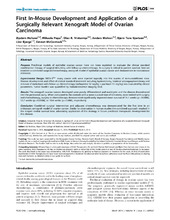| dc.contributor.author | Helland, Øystein | en_US |
| dc.contributor.author | Popa, Mihaela Lucia | en_US |
| dc.contributor.author | Vintermyr, Olav Karsten | en_US |
| dc.contributor.author | Molven, Anders | en_US |
| dc.contributor.author | Gjertsen, Bjørn Tore | en_US |
| dc.contributor.author | Bjørge, Line | en_US |
| dc.contributor.author | McCormack, Emmet | en_US |
| dc.date.accessioned | 2015-03-23T14:58:21Z | |
| dc.date.available | 2015-03-23T14:58:21Z | |
| dc.date.issued | 2014-03-04 | eng |
| dc.identifier.issn | 1932-6203 | |
| dc.identifier.uri | https://hdl.handle.net/1956/9620 | |
| dc.description.abstract | Purpose: Preclinical models of epithelial ovarian cancer have not been exploited to evaluate the clinical standard combination therapy of surgical debulking with follow-up chemotherapy. As surgery is critical to patient survival, here we establish a combined surgical/chemotherapy xenograft model of epithelial ovarian cancer and demonstrate its translational relevance. Experimental Design: SKOV-3luc+ ovary cancer cells were injected topically into the ovaries of immunodeficient mice. Disease development and effect of clinical standard treatment including hysterectomy, bilateral salpingoophorectomy and removal of metastasis with follow up chemotherapy (carboplatin 12 mg/kg + paclitaxel 15 mg/kg) was evaluated by clinical parameters. Tumor burden was quantified by bioluminescence imaging (BLI). Results: The xenograft ovarian tumors developed were poorly differentiated and multicystic and the disease disseminated into the peritoneal cavity. When compared to the controls with a mean survival time of 4.9 weeks, mice treated with surgery and chemotherapy, surgery or chemotherapy demonstrated significantly improved mean survival of 16.1 weeks (p = 0.0008), 12.7 weeks (p = 0.0008), or 10.4 weeks (p = 0.008), respectively. Conclusion: Combined surgical intervention and adjuvant chemotherapy was demonstrated for the first time in an orthotopic xenograft model of ovarian cancer. Similar to observation in human studies the combined approach resulted in the longest medial survival time, advocating application of this strategy in future preclinical therapeutic development for this disease. | en_US |
| dc.language.iso | eng | eng |
| dc.publisher | The University of Bergen | eng |
| dc.rights | Attribution CC BY | eng |
| dc.rights.uri | http://creativecommons.org/licenses/by/3.0/ | eng |
| dc.title | First in-mouse development and application of a surgically relevant xenograft model of ovarian carcinoma | en_US |
| dc.type | Peer reviewed | |
| dc.type | Journal article | |
| dc.date.updated | 2015-03-03T15:26:02Z | en_US |
| dc.description.version | publishedVersion | en_US |
| dc.rights.holder | Copyright 2014 Helland et al. | |
| dc.source.articlenumber | 89527 | |
| dc.identifier.doi | https://doi.org/10.1371/journal.pone.0089527 | |
| dc.identifier.cristin | 1153817 | |
| dc.source.journal | PLoS ONE | |
| dc.source.40 | 9 | |
| dc.source.14 | 3 | |
| dc.subject.nsi | VDP::Medical sciences: 700::Clinical medical sciences: 750::Oncology: 762 | eng |
| dc.subject.nsi | VDP::Medisinske fag: 700::Klinisk medisinske fag: 750::Onkologi: 762 | nob |

